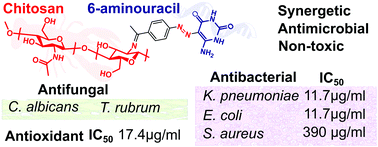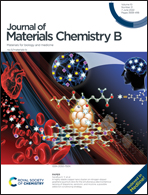Chitosan with pendant (E)-5-((4-acetylphenyl)diazenyl)-6-aminouracil groups as synergetic antimicrobial agents†
Abstract
Conventional antimicrobial agents are losing the war against drug resistance day-by-day. Chitosan biopolymer is one of the alternative materials that lends itself well to this application by fine-tuning its bioactivity using different pendant groups. Herein, we report the synthesis of novel chitosan with pendant (E)-5-((4-acetylphenyl)diazenyl)-6-aminouracil (APAU) groups by forming Schiff base linkages between chitosan and the pendant groups. These chitosan biopolymers with pendant APAU groups form films superior in thermal stability compared to the neat chitosan. Interestingly, APAU alone was inactive against K. pneumoniae, E. coli, S. aureus, T. rubrum and C. albicans. However, novel chitosan samples were active against S. aureus with an MIC of 390 μg mL−1, half that of plain chitosan at 780 μg mL−1. APAU modified chitosan samples, CA80 and CA100 showed an MIC (against K. pneumoniae and E. coli) of 23.4 μg mL−1, superior to plain chitosan's MIC of 187.5 μg mL−1 and is close to commercial Fluconazole's MIC of 11.7 μg mL−1. The activity of chitosan changes with APAU content and at higher concentrations shows a strong synergetic antimicrobial effect.



 Please wait while we load your content...
Please wait while we load your content...